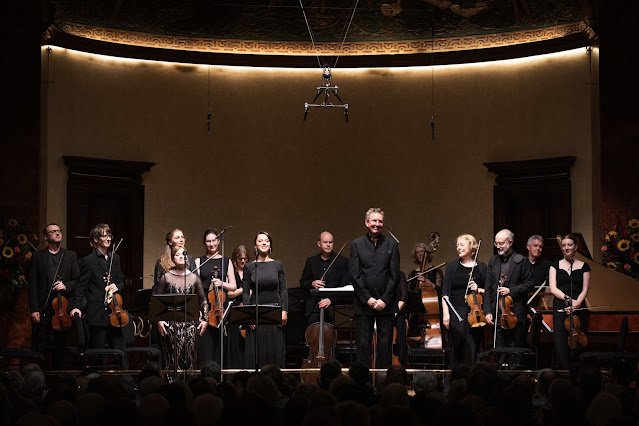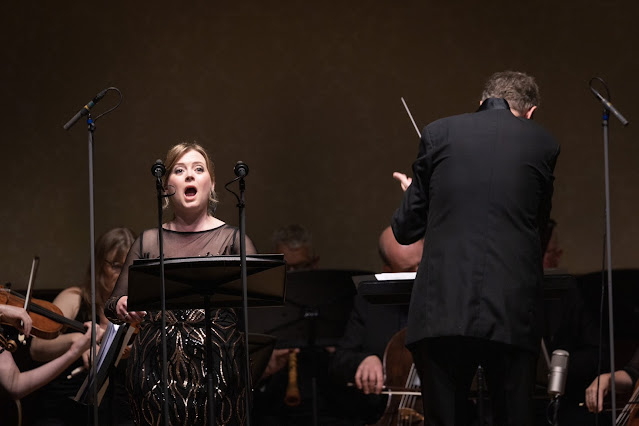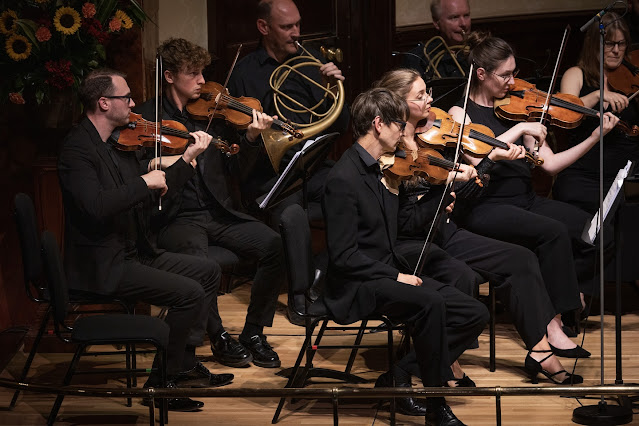 |
| Jommelli: a celebration – Fflur Wyn, Ambroisine Bré, Ian Page, The Mozartists at Wigmore Hall (Photo: Benjamin Ealovega) |
Jommelli – a celebration: Fflur Wyn, Ambroisine Bré, Hugo Brady, The Mozartists, Ian Page; Wigmore Hall
Reviewed 18 September 2024
Celebrating the 250th anniversary of Jommelli’s death with an evening of his fascinating and unjustly neglected music in killer performances from a trio of soloists that combined virtuoso dazzle with emotional commitment and great style
Opera composer Niccolò Jommelli died 250 years ago this year, not that you would know it looking at opera companies schedules. In a world where pre-Mozartian 18th century opera seems to start at Handel and stop at Gluck, with a brief stop at Vivaldi, exploring further is rare. Jommelli was enormously popular in his day, wrote some 80 operas and was something of a revolutionary. But since his death in 1774 he has been substantially ignored.
In 2016, Ian Page and The Mozartists revived Jommelli’s opera Il Vologeso and now they followed that up with a concert exploring the composer’s whole operatic output, 12 arias and duets spanning a 34 year period. At Wigmore Hall on Wednesday 18 September 2024, Ian Page conducted the Mozartists in Jommelli – a celebration, with soloists Fflur Wyn, Ambroisine Bré and Hugo Brady.
 |
| Jommelli: a celebration – Fflur Wyn, Ian Page, The Mozartists at Wigmore Hall (Photo: Benjamin Ealovega) |
Shortly before the concert, a conductor’s worst nightmare happened; faced with a programme of rare and unperformed virtuoso vocal music, soprano Emily Pogorelc became ill and was unable to sing. Enter soprano Fflur Wyn who with remarkable virtuosity, killer sight-reading skills (presumably), superb aplomb, and a fabulous frock, sang the soprano solos. And don’t forget that at that period, the soprano was the diva, so Wyn got to be Dido dying and Armida vowing her revenge on Rinaldo, along with much else besides.
Niccolò Jommelli was from the influential Neapolitan school that not only produced castratos such as Farinelli but composers like Niccolo Porpora who wrote dazzling vehicles for the star singers. Jommelli, however, would move in another direction. His large output of operas was written for Rome, Venice, Bologna, and other Italian cities, often setting the librettos of Metastasio. In 1753, Jommelli was made Kapellmeister to Duke Karl Eugen of Württemberg in Stuttgart, and Jommelli wrote some 27 operas for the Duke which were premiered in the theatre in the Duke’s palace at Ludwigsburg. Mozart and his father Leopold passed through Ludwigsburg in 1763 on their “grand tour” and met the composer.
The Duke was licentious, pleasure-loving and spendthrift, but one of his interests was opera and he developed a taste for French opera when visiting Paris. He seems to have given Jommelli a relatively free hand, so Jommelli’s operas for Stuttgart start to experiment. He concentrates more on the story and the drama rather than writing display arias and included more ensembles and choruses. He built up one of the finest orchestras in Europe, numbering 47 by 1767; there is greater use of the orchestra in the recitatives, and greater use of the orchestra altogether, and ballet as well.
Jommelli’s long-time was collaborator librettist Mattia Verazi and the two created works that are a long way from Metastasian opera seria, full of personal emotion and even dropping the exit aria convention. Verazi wrote an Ifegenia in Aulide with Jommelli in Rome in 1751 (a very Gluckian subject that), and from 1755 Verazi would write several librettos for Jommelli’s Stuttgart operas.
Jommelli’s travels may have given him a chance to experience French tragédie en musique in some way. He seems to have written one opera for Parma, a French sphere of influence and intriguingly would revise one of his Italian operas for Paris. Both of these works point to the cross-pollination between French and Italian opera. Jommelli would be influenced in his use of ballets by the operas of Jean-Philippe Rameau, whose operas date from his later years, 1733-1763. And both Parma and Paris were places to hear all things French.
In 1758, the Duke would fit-out the theatre in his palace at Ludwigsburg (the largest Baroque palace in Europe). The theatre had been built by the Duke’s father, but it was Duke Karl Eugen who installed the very latest in theatrical equipment. The theatre still survives and is used for performances, but the auditorium was re-fitted in the latest neo-classical style in the early 19th century.
We began with ‘Vidi il mar tutto in procella’ from Ricimero re de’ Goti (1740) sung by Fflur Wyn. A simile aria about navigating a storm, it was vividly virtuoso from the outset with Wyn performing with confident style and expressiveness. The virtuoso elements were astonishing on many counts. Next came ‘Se il povero ruscello’ from Ezio (1741) sung by Hugo Brady. Another simile aria, this time a stream moving from murmuring to agitated. The opening featured much murmuring in the orchestra, our first indication of how fascinating Jommelli’s orchestral writing could be. Hugo Brady sang with engaging lyricism, fine attention to the words and stylish bravura. The aria ‘Io già sento nel mio petto’ from Merope (1740) featured Ambroisine Bré. This was an aria notable for the busy moving parts of the accompaniment and the natural way Bré’s stylish line incorporated the ornamentation.
Jommelli wrote three settings of Metastasio’s Didone abbandonata and the final one, written in 1763 for Stuttgart, reflected his changing views on operatic drama. In this version Dido actually does die at the end (quite a novelty in 18th century opera where the lieto fine was still necessary). We heard the final scene, sung by Fflur Wyn. Far from conventional, it began with striking accompanied recitative that closely followed Dido’s emotions, then the final aria was much more arioso. The whole was very fluid in style especially as the ending moved back to dramatic recitative, responding to Dido’s emotions, and eschewed a bravura ending, Dido launches herself into the flames and Jommelli concluded with a dramatic sinfonia. Wyn and the orchestra joined together to give a remarkable performance, really taking us through Dido’s emotions, and the orchestra was very much a partner here, Jommelli’s orchestral writing full of colour and movement.
Il Vologeso was the opera that Ian Page revived in 2016, but it was no less fascinating to have an excerpt here. Hugo Brady sang ‘De’ miei desiri ormai … Che farò’. The opera, which premiered in 1764, had a libretto by Verazi which reworked one by Apostolo Zeno, and Jommelli and Verazi set about challenging the formulaic nature of opera seria. Here we had a striking accompanied recitative where material from the orchestra’s introduction punctuated Brady’s quite bare vocal line, to highly expressive effect. The scene finished with a cavatina, but certainly not a negligible little lyrical movement, this was full of imaginative touches along with another anti-bravura ending.
The first half ended with the duet, ‘La destra ti chiedo’ from Demofoonte. The plot is one of the barmier of Metastasio’s, including suspected accidental incest. But here we had a love duet, sung by Wyn and Bré, from Jommelli’s 1764 opera. Again, we had an accompanied recitative with distinctive use of the orchestra, and the aria itself was interestingly complex in construction. Jommelli’s music does not go into the achingly beautifully farewell duets of Handel, but instead the mood was determined, and also rather virtuoso.
After the interval, Fflur Wyn returned to sing ‘Ombre che tacite qui sede’ from Fetonte which premiered in 1768 in the Duke’s new, technically advanced, theatre. The opera uses a libretto which Verazi based on Philippe Quinault’s 1783 text for Lully’s Phaeton and the opera was intended to show the theatre off to its maximum. Besides the theatrical technology and display, it is worth remembering that the ballet master was innovative too so that the danced elements were just as advanced as the design and the music.
The aria evoked otherworldliness, with a string accompaniment that was striking and evocative, creating an interesting soundscape over which Jommelli set a rather direct vocal line. Bré then returned with something completely different, ‘Heureuse paix tranquille’ from La critica, a 1766 opera satirising operatic production. Here the aria was supposed to send up the habit of putting different languages together, but Jommelli takes the French text seriously and produced a little French-style aria full of ravishing delights.
We then moved on to Armida abbandonata written in 1770 for Naples, where Jommelli had moved following his departure from Stuttgart. Mozart and his father were in the audience for the premiere. Here Hugo Brady sang ‘Fra l’orror di notte oscura’, another simile aria which enabled orchestra and soloist to give us plenty of excitement and busyness, with Brady singing the ornamentation, along with striking leaps, with aplomb. Yet they found drama in the aria too, this was not about simple display.
That came over in Jommelli’s Ifigenia in Tauride, his second opera for Naples in 1771. In fact, this was a re-write of a 1764 version of the opera, but for Naples, Jommelli stripped out some of the more unconventional elements and stuck to the Metastasian model of (da capo) aria and recitative. However, the opera failed! We heard a scene for Orestes, sung by Bré, with contributions from Wyn and Brady in the dramatic recitative. Orestes’ aria featured a surprisingly direct vocal line, sung movingly by Bré and only the ending was substantially bravura.
Il trionfo di Clelia was Jommelli’s last opera, written in the face of illness with the help of an amateur musician, Giuseppe Sigismondo who acted as amanuensis. Jommelli never saw the opera, the manuscript was sent off to Portugal where it was premiered in Lisbon, though reports of its enthusiastic reception reached the composer a few weeks before his death.
Hugo Brady sang ‘Sol del Tebro in su la sponda’, an aria with lots of moving parts, creating interesting orchestral textures and a lyrical vocal line sung with warmth by Brady. This was a substantial and complex piece, and Brady made it rather moving.
We ended with a return to the 1770 version of Armida abbandonata with Fflur Wyn giving us Armida’s final scene. Again, what Jommelli gave us was an extremely fluid scene which moved between accompanied recitative, aria and arioso, and enabled Wyn to really demonstrate her commitment to the emotional drama of the piece. Throughout, there was a significant orchestral contribution and the ending featured a striking accompanied recitative as Armida leaves in her dragon-drawn chariot, followed by the wonderful orchestral depiction.
 |
| Jommelli: a celebration – The Mozartists at Wigmore Hall (Photo: Benjamin Ealovega) |
Hearteningly the hall was full. Few people, I suspect, had heard much music by Jommelli and I do hope that the evening whetted people’s appetites. What was striking was the way all three soloists went well beyond virtuoso bravura to find the real drama in this music, aided, abetted and partnered by the superb playing of the Mozartists under Ian Page’s deft direction. This was an evening given with love.
We were treated to an encore, Ambroisine Bré sang a sleep aria from one of Jommelli’s operas which led seamlessly into a Requiem in aeternam with all three.
The blog is free, but I’d be delighted if you were to show your appreciation by buying me a coffee.
Elsewhere on this blog
- Fire and water in the library: Siren Duo in an imaginative flute and harp recital for Temple Music – concert review
- An interview with the Snow Maiden: I chat to Ffion Edwards about taking on the title role in Rimsky Korsakov’s opera with English Touring Opera – interview
- A journey of remarkable emotional depth: Laurence Kilsby and Ella O’Neill at Wigmore Hall – concert review
- Engaging charm: Bampton Classical Opera in a delightful version of Alcina that does not take itself too seriously – opera review
- The Game: director Leo Doulton on blending opera with interactive storytelling and video game at this year’s Tête à Tête – interview
- Web of influences: Harry Christophers & The Sixteen’s Choral Pilgrimmage at Old Royal Naval College Chapel, Greenwich – concert review
- L’Olimpiade: Vache Baroque makes an engaging case for Pergolesi’s penultimate opera – opera review
- A subtle depiction of a complex man: Green Opera’s 555, Verlaine en prison at Grimeborn – opera review
- Scaling the peak: David Skinner on recording Byrd’s The Great Service with Alamire reflecting new ideas about pitch and scoring – interview
- Discovering Imogen: A relatively underrated British composer, Imogen Holst is put centre stage in this brand-new recording on NMC – record review
- Home









